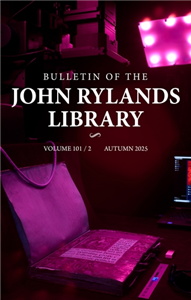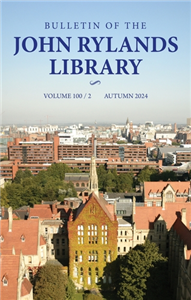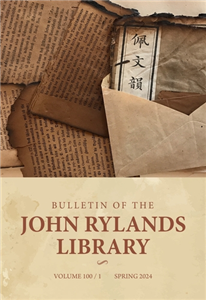Your Search Results
-
Al-Kamel Verlag / Manshourat Al Jama
Manshurat Al Jamal was founded in 1983 by Khalid Al Maaly in Cologne ,in 2008 based in Beirut and a further branch in Bagdad .The program focus on :- Classic ,Modern Arab literature- Fiction short stories poems - Philosophy- Sociology Manshurat Al-Jamal is the publisher of a lot of authors: G.Grass O. Pamuk J. Habermas Robert Musil H.Qureishi G. Sinoue P. Celan W. Gombrowicz J. Derrida M. Horkheimer T. Adorno A. Kristof
View Rights Portal
-
Promoted ContentJanuary 1992
Georg Iwanowitsch Gurdjieff
Magier, Mystiker, Menschenfänger. Eine Biographie
by Moore, James / Übersetzt von Schuhmacher, Erwin
-
Promoted ContentHumanities & Social SciencesDecember 2025
Bulletin of the John Rylands Library 101/2
Imaging Heritage Science Initiatives at The John Rylands Research Institute and Library
by Stefan Hanß, James Robinson
The John Rylands Library houses one of the finest collections of rare books, manuscripts and archives in the world. The collections span five millennia, have a global reach and cover a wide range of subjects, including art and archaeology; economic, social, political, religious and military history; literature, drama and music; science and medicine; theology and philosophy; travel and exploration. For over a century, the Bulletin of the John Rylands Library has published research that complements the Library's special collections. An electronic edition of this issue is freely available under a Creative Commons (CC BY-NC-ND) licence.
-
 Trusted Partner
Humanities & Social SciencesMarch 2017
Trusted Partner
Humanities & Social SciencesMarch 2017Child, nation, race and empire
Child rescue discourse, England, Canada and Australia, 1850–1915
by Margot Hillel, Shurlee Swain, Andrew Thompson, John M. MacKenzie
Child, nation, race and empire is an innovative, inter-disciplinary, cross cultural study that contributes to understandings of both contemporary child welfare practices and the complex dynamics of empire. It analyses the construction and transmission of nineteenth-century British child rescue ideology. Locating the origins of contemporary practice in the publications of the prominent English Child rescuers, Dr Barnardo, Thomas Bowman Stephenson, Benjamin Waugh, Edward de Montjoie Rudolf and their colonial disciples and literature written for children, it shows how the vulnerable body of the child at risk came to be reconstituted as central to the survival of nation, race and empire. Yet, as the shocking testimony before the many official enquiries into the past treatment of children in out-of-home 'care' held in Britain, Ireland, Australia and Canada make clear, there was no guarantee that the rescued child would be protected from further harm.
-
 Trusted Partner
Humanities & Social SciencesMarch 2020
Trusted Partner
Humanities & Social SciencesMarch 2020Knowledge, mediation and empire
James Tod's journeys among the Rajputs
by Florence D'Souza, Andrew Thompson, John M. MacKenzie
This study of the British colonial administrator James Tod (1782-1835), who spent five years in north-western India (1818-22) collecting every conceivable type of material of historical or cultural interest on the Rajputs and the Gujaratis, gives special attention to his role as a mediator of knowledge about this little-known region of the British Empire in the early nineteenth century to British and European audiences. The book aims to illustrate that British officers did not spend all their time oppressing and inferiorising the indigenous peoples under their colonial authority, but also contributed to propagating cultural and scientific information about them, and that they did not react only negatively to the various types of human difference they encountered in the field.
-
 Trusted Partner
Humanities & Social SciencesDecember 2024
Trusted Partner
Humanities & Social SciencesDecember 2024Bulletin of the John Rylands Library 100/2
Higher Learning and Civic Cultures of Knowledge: Manchester 1824–2024
by Stuart Jones
The John Rylands Library houses one of the finest collections of rare books, manuscripts and archives in the world. The collections span five millennia, have a global reach and cover a wide range of subjects, including art and archaeology; economic, social, political, religious and military history; literature, drama and music; science and medicine; theology and philosophy; travel and exploration. For over a century, the Bulletin of the John Rylands Library has published research that complements the Library's special collections.
-
 Trusted Partner
Humanities & Social SciencesJune 2025
Trusted Partner
Humanities & Social SciencesJune 2025Bulletin of the John Rylands Library 101/1
by Fred Schurink, Rachel Winchcombe, Huw Twiston Davies
The John Rylands Library houses one of the finest collections of rare books, manuscripts and archives in the world. The collections span five millennia, have a global reach and cover a wide range of subjects, including art and archaeology; economic, social, political, religious and military history; literature, drama and music; science and medicine; theology and philosophy; travel and exploration. For over a century, the Bulletin of the John Rylands Library has published research that complements the Library's special collections. An electronic edition of this issue is freely available under a Creative Commons (CC BY-NC-ND) licence.
-
 Trusted Partner
Trusted Partner
-
 Trusted Partner
Trusted Partner
-
 Trusted Partner
Humanities & Social SciencesMarch 2017
Trusted Partner
Humanities & Social SciencesMarch 2017The Arctic in the British imagination 1818–1914
by Andrew Thompson, John M. MacKenzie, Rob David
The Arctic region has been the subject of much popular writing. This book considers nineteenth-century representations of the Arctic, and draws upon an extensive range of evidence that will allow the 'widest connections' to emerge from a 'cross-disciplinary analysis' using different methodologies and subject matter. It positions the Arctic alongside more thoroughly investigated theatres of Victorian enterprise. In the nineteenth century, most images were in the form of paintings, travel narratives, lectures given by the explorers themselves and photographs. The book explores key themes in Arctic images which impacted on subsequent representations through text, painting and photography. For much of the nineteenth century, national and regional geographical societies promoted exploration, and rewarded heroic endeavor. The book discusses images of the Arctic which originated in the activities of the geographical societies. The Times provided very low-key reporting of Arctic expeditions, as evidenced by its coverage of the missions of Sir John Franklin and James Clark Ross. However, the illustrated weekly became one of the main sources of popular representations of the Arctic. The book looks at the exhibitions of Arctic peoples, Arctic exploration and Arctic fauna in Britain. Late nineteenth-century exhibitions which featured the Arctic were essentially nostalgic in tone. The Golliwogg's Polar Adventures, published in 1900, drew on adult representations of the Arctic and will have confirmed and reinforced children's perceptions of the region. Text books, board games and novels helped to keep the subject alive among the young.
-
 Trusted Partner
1985
Trusted Partner
1985Geschichten vom Tierarzt Dr. James Herriot
Der Doktor und das liebe Vieh und Dr. James Herriot, Tierarzt
by Herriot, James / Übersetzt von Kloth, Friedrich A; Übersetzt von Herrera, Ulla H de
-
 Trusted Partner
December 2001
Trusted Partner
December 2001Die Formen des Religiösen in der Gegenwart
by Charles Taylor, Karin Wördemann, Charles Taylor
Ausgehend von William James' 1902 erschienener Untersuchung "Die Vielfalt religiöser Erfahrung" verfolgt Charles Taylor die Verschiebungen im Verhältnis von Religion, Individuum und Gesellschaft, von Spirituellem und Politischem bis in die Gegenwart. Der Rückzug des religiösen aus der öffentlichen Sphäre hat die Religion nicht ins Private eingeschlossen; vielmehr verbirgt sich hinter diesem Prozeß eine Kulturrevolution: Der moderne »expressive« Individualismus hat eine Vielfalt neuer Religionsformen und -gemeinschaften hervorgebracht, die auf die traditionellen Formen zurückwirkt und die Gesellschaft verändert. Der Ort der Religion muß neu bestimmt werden.
-
 Trusted Partner
February 2007
Trusted Partner
February 2007Mister Moores Wortgestöber
Ein Wegweiser durch die Sprachen der Welt
by Moore, C.J / Deutsch Strüh, Christine
-
 Trusted Partner
The ArtsOctober 2017
Trusted Partner
The ArtsOctober 20174 saints in 3 acts
A snapshot of the American avant-garde in the 1930s
by Patricia Allmer, John Sears
Four Saints in Three Acts by Gertrude Stein and Virgil Thomson was a major avant-garde phenomenon of the 1930s, an experimental opera that nonetheless achieved remarkable popular success. Photography was a key element of that success, but its complex roles in the construction, representation and dissemination of the opera have hitherto received little critical attention. The photographic recording of the all-African American cast in particular affords a unique insight into the complexities of Four Saints in relation to the Harlem Renaissance and the New York avant-gardes of the time. This book, published in collaboration with The Photographers' Gallery, London, presents a wide selection of photographs of the cast, performances, and other material - many images reproduced for the first time - alongside essays by an international range of scholars exploring different aspects of the opera, including dance, fashion, music, and avant-garde writing, as well as photography.
-
 Trusted Partner
Literature & Literary StudiesApril 2021
Trusted Partner
Literature & Literary StudiesApril 2021John Derricke's The Image of Irelande: with a Discoverie of Woodkarne
by Thomas Herron, Denna Iammarino, Maryclaire Moroney, Joshua Samuel Reid
-
 Trusted Partner
Humanities & Social SciencesOctober 2024
Trusted Partner
Humanities & Social SciencesOctober 2024Bulletin of the John Rylands Library 100/1
by Fred Schurink, Rachel Winchcombe
The John Rylands Library houses one of the finest collections of rare books, manuscripts and archives in the world. The collections span five millennia, have a global reach and cover a wide range of subjects, including art and archaeology; economic, social, political, religious and military history; literature, drama and music; science and medicine; theology and philosophy; travel and exploration. For over a century, the Bulletin of the John Rylands Library has published research that complements the Library's special collections.
-
 Trusted Partner
Trusted Partner
-
 Trusted Partner
Trusted Partner
-
 Trusted Partner
September 2016
Trusted Partner
September 2016Bottom's Dream
by Arno Schmidt, John E. Woods
35 Jahre lang hat John E. Woods Arno Schmidt übersetzt, fast das gesamte literarische Werk des deutschen Schriftstellers übertrug der Amerikaner in seine Muttersprache. Die erste Schmidt-Lektüre war für ihn eine »Explosion« – mit Schmidts »Evening Edged in Gold« (»Abend mit Goldrand«) hat der preisgekrönte Übersetzer seine Karriere einst begonnen, dessen wichtigstes und umfangreichstes Werk hob sich Woods bis zum Schluss auf: Jetzt liegt der Überroman »Zettel’s Traum« endlich auf Englisch vor. Schmidts Sprachspiele, eine Herausforderung für jeden Übersetzer, hat Woods immer kreativ in die flexible englische Sprache übertragen, und manchmal ist seine Lösung witziger als das Original. John E. Woods über Bottom’s Dream: »›I have had a dream past the wit of man to say what dream it was,‹ says Bottom. ›I have had a dream, and I wrote a Big Book about it,‹ Arno Schmidt might have said. Schmidt’s rare vision is a journey into many literary worlds. First and foremost it is about Edgar Allan Poe, or perhaps it is language itself that plays that lead role; and it is certainly about sex in its many Freudian disguises, but about love as well, whether fragile and unfulfilled or crude and wedded.«
-
 Trusted Partner
Trusted Partner
-
 Trusted Partner
Trusted Partner





















